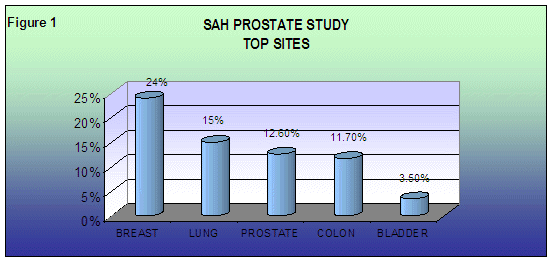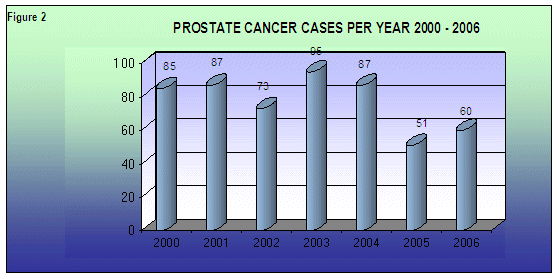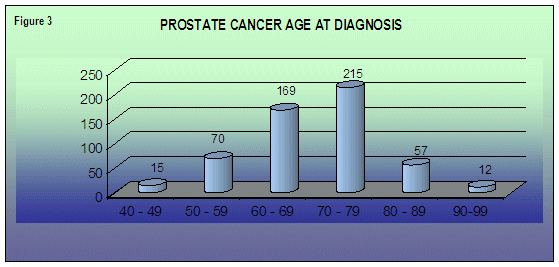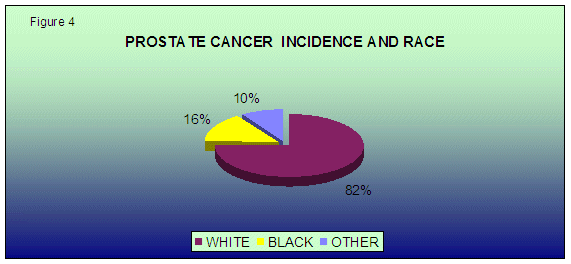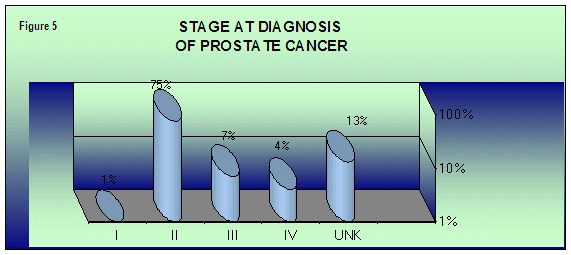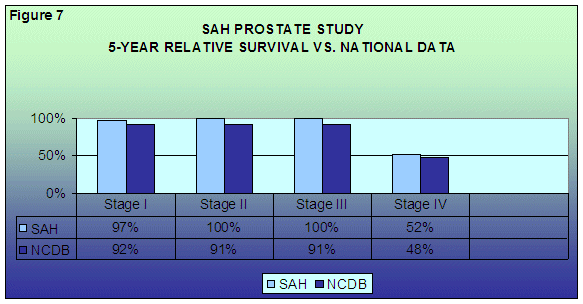|
2007 PATIENT CARE EVALUATION PROSTATE CANCER
INTRODUCTION Prostate cancer is the most common cancer in men in the U.S. with a lifetime risk of 17.1%. Prostate cancer accounts for 16% of all cancers and 33% of all cancers in men. It is the third most common cancer seen at St. Anthony’s Hospital (SAH), accounting for 12.6% of all cases in the Cancer Registry (Figure 1). The Cancer Committee reviewed 538 analytic cases for the study period from 2000 through 2006. A slight declined in 2005 & 2006 data, was thought to be related to referral patterns. (Figure 2).
AGE AT DIAGNOSIS The median age at diagnosis was 65, with 71% of all diagnosed falling between the ages of 60 and 79. This is higher than age of diagnosis nationally reflecting Florida’s older population (Figure 3).
INCIDENCE AND RACE The racial distribution was 82% Caucasian and 16% African-American (Figure 4).
STAGE AT DIAGNOSIS More of our patients (75%) were diagnosed in Stage II disease than any other stage (Figure 5). This reflects earlier detection, through PSA screening and examination. Men diagnosed with early-stage prostate cancer should be counseled about treatment options and issues related to morbidity and quality of life, as per the guidelines from the NCI and the NCCN .
TREATMENT Surgery continues to be the predominant choice at SAH, followed by Radiation Therapy. It is difficult to make outcome comparisons between surgery and radiation, but both forms of treatment appear to have excellent results based on survival data (Figure 6).
SURVIVAL Analysis of the 5-year relative survival of prostate cancer patients for all stages reveals a survival rate of 100%. With the widespread use of PSA screening, this cancer is almost always diagnosed at the earliest stages (Figure 7).
SUMMARY The data reviewed for the past six years indicate that the incidence of prostate cancer seen at SAH compares favorably with national norms. The American Cancer Society recommends that prostate cancer screenings begin at age 50; those who are at increased risk, particularly African American or those with a family history of prostate cancer, should start screening at age 40. New screening guidelines from the NCCN encourage considering a biopsy for patients with PSA greater than 2.5, which is a change from previous years and even consider closer monitoring for patients with PSA greater than 0.6 if the man is still in his forties. Controversy remains as to optimal treatment with most patients opting for radical prostatectomy or radiation (external beam or seed implants). It is the recommendation of the Cancer Committee that patients should be offered the various treatment options as detailed in the NCCN guidelines. The survival data and comparisons with national benchmark data show excellent survival outcomes in men treated at St. Anthony’s Hospital.
Robert Miller, MD Radiation Oncologist |
